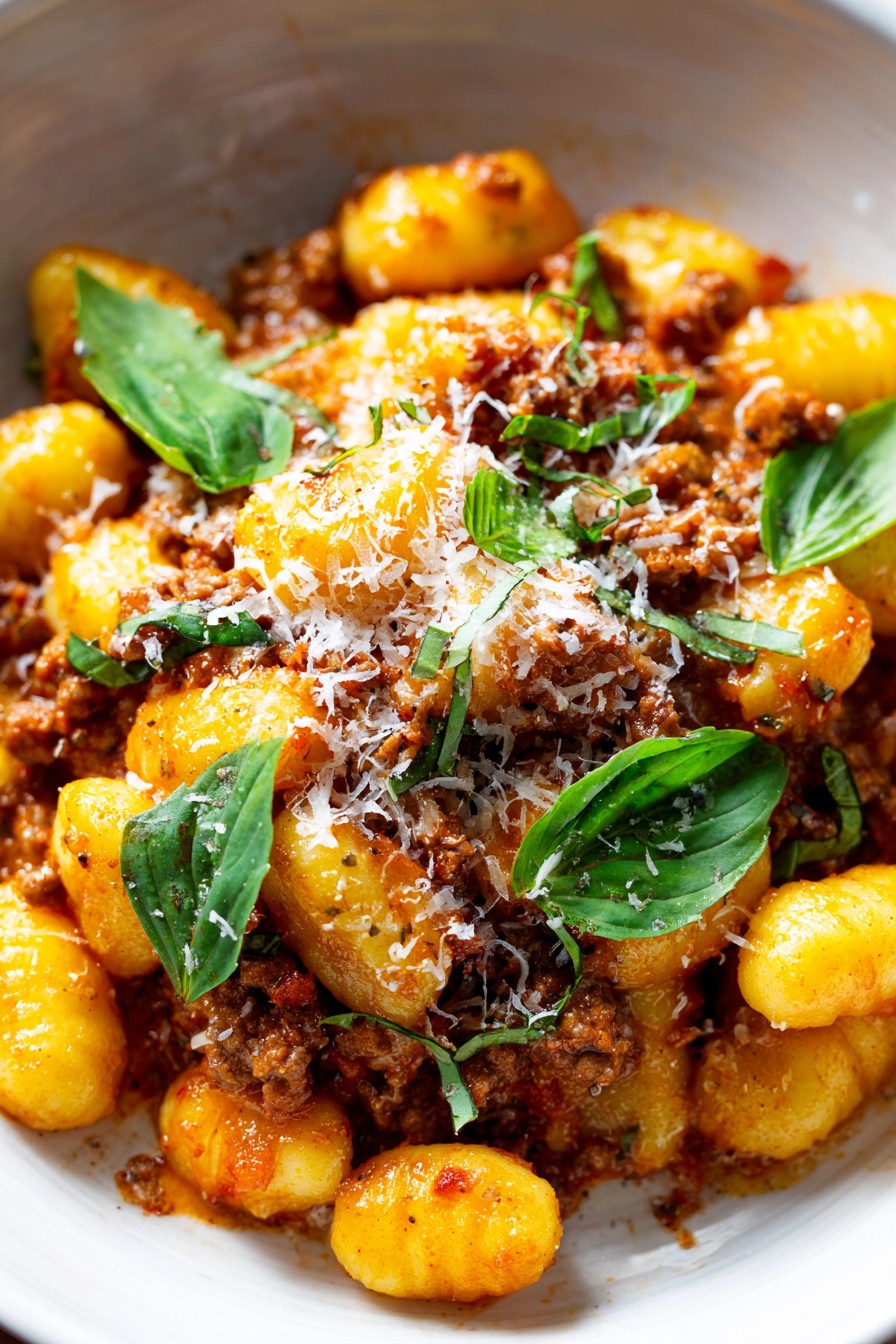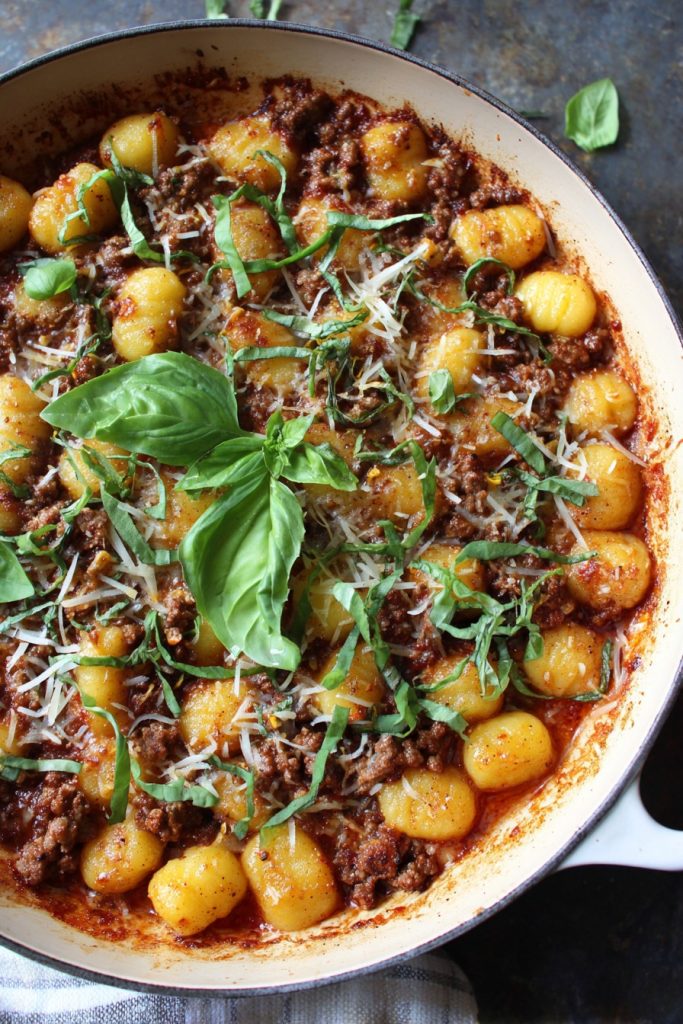You’re about to experience gnocchi transformed from simple potato dumplings into a flavor explosion that will haunt your cravings for weeks. This isn’t just dinner—it’s a textural symphony where pillowy soft gnocchi meets the aggressive spice of Italian sausage, all swimming in a garlic-infused tomato sauce that clings to every bite with delicious intensity.
Why This Recipe Works
- The high-fat content in Italian sausage creates an incredible flavor foundation as it renders, coating the gnocchi in rich, spicy oils that penetrate every surface
- Pan-searing the gnocchi creates a crispy golden crust that contrasts spectacularly with their cloud-like interior, delivering multiple textures in every single bite
- Using the sausage drippings to cook the aromatics infuses the entire dish with deep, meaty undertones that store-bought sauces can never replicate
- The quick-cooking nature of pre-made gnocchi means you achieve restaurant-quality results in under 30 minutes without sacrificing complexity or depth
- Fresh basil added at the finish provides bright, herbal notes that cut through the richness, balancing the dish perfectly
Ingredients
- 1 pound shelf-stable potato gnocchi
- 1 pound hot Italian sausage, casings removed
- 1 large yellow onion, finely diced
- 4 cloves garlic, minced
- 1 (28-ounce) can crushed tomatoes
- 1/2 cup heavy cream
- 1/4 cup grated Parmesan cheese, plus more for serving
- 2 tablespoons olive oil
- 1 teaspoon red pepper flakes
- 1/2 cup fresh basil leaves, torn
- Salt and freshly ground black pepper to taste
Equipment Needed
- Large skillet or sauté pan
- Wooden spoon or spatula
- Chef’s knife
- Cutting board
- Measuring cups and spoons
- Large pot for boiling water (optional)
Instructions

Brown the Sausage to Perfection
Heat your largest skillet over medium-high heat and add the olive oil. When the oil shimmers and dances across the surface, crumble the Italian sausage into the pan, breaking it into rough, uneven chunks that will create varied textures. Listen for that satisfying sizzle as the meat hits the hot surface—this is where the magic begins. Cook for 6-8 minutes, resisting the urge to stir constantly. Let the sausage develop deep brown crusts on one side before flipping, as these caramelized bits contain incredible flavor compounds. The sausage should release its spicy, aromatic oils, which will pool in the pan and become our cooking medium for everything that follows. You’ll know it’s ready when the pieces are browned with crispy edges but still juicy inside.
Build Your Flavor Foundation
Reduce the heat to medium and push the sausage to one side of the pan, allowing the rendered fat to pool on the empty surface. Add the diced onion to this golden liquid and watch as it immediately sizzles, absorbing all that porky goodness. Cook for 4-5 minutes until the onions turn translucent and their edges begin to caramelize, developing a sweet complexity that balances the sausage’s spice. Now add the minced garlic and red pepper flakes, stirring constantly for just 60 seconds until the garlic becomes fragrant but hasn’t browned—overcooked garlic turns bitter and will ruin your sauce. The aroma at this stage should be intoxicating: sweet onions, pungent garlic, and the warm heat of chili flakes all mingling with the sausage’s savory notes.
Create the Luscious Sauce
Pour the crushed tomatoes into the pan, listening to that satisfying sizzle as the cool liquid hits the hot surface. Stir everything together, scraping up any browned bits from the bottom of the pan—these flavor-packed fond particles will dissolve into your sauce, adding incredible depth. Bring the mixture to a vigorous bubble, then reduce to a gentle simmer. Cook for 10-12 minutes, stirring occasionally, until the sauce thickens slightly and the raw tomato taste mellows into something sweet and complex. Now pour in the heavy cream, watching as it swirls through the red sauce creating beautiful marbled patterns before blending into a rich, coral-colored masterpiece. The cream tempers the tomatoes’ acidity while adding luxurious body.
Cook the Gnocchi to Textural Excellence
While the sauce simmers, bring a large pot of salted water to a rolling boil. Add the gnocchi and cook according to package directions until they float to the surface—usually 2-3 minutes. Drain immediately, but don’t rinse; the surface starch helps the sauce cling to each dumpling. Now for the game-changing step: heat a separate tablespoon of olive oil in a clean skillet over medium-high heat. Add the drained gnocchi in a single layer and cook for 2-3 minutes per side until they develop golden-brown crusts. This technique transforms their texture from simply soft to magnificently multi-dimensional—crispy exteriors giving way to pillowy interiors.
Combine and Finish with Flair
Gently fold the seared gnocchi into your simmering sausage sauce, taking care not to break the delicate dumplings. Sprinkle in the grated Parmesan cheese, stirring as it melts and emulsifies into the sauce, adding salty, umami depth and helping thicken the consistency. Taste and season aggressively with salt and freshly cracked black pepper—the gnocchi and sausage both need proper seasoning to shine. Remove from heat and stir in the torn basil leaves, which will wilt slightly from the residual heat while retaining their bright, peppery flavor. The final dish should be a beautiful marriage of textures and colors: white gnocchi peeking through crimson sauce, green basil scattered throughout, and chunks of spicy sausage in every bite.
Tips and Tricks
For those looking to elevate this dish from fantastic to extraordinary, consider these advanced techniques. First, if you have access to a meat grinder, create your own sausage blend using 80% pork shoulder and 20% pork fat, seasoned with fennel seeds, garlic powder, paprika, and red pepper flakes—the freshness will blow away any store-bought alternative. When searing your gnocchi, don’t overcrowd the pan; work in batches if necessary to ensure each dumpling gets proper contact with the hot surface, creating maximum crispiness. For sauce depth, consider deglazing your pan with a splash of red wine after browning the sausage—let it reduce by half before adding onions to incorporate another layer of complexity. If you prefer homemade gnocchi, roast your potatoes instead of boiling them for concentrated flavor, and incorporate one egg yolk per pound of potatoes for richer color and tenderness. For creamier texture without heaviness, substitute half the heavy cream with whole milk ricotta stirred in at the very end—it creates pockets of creamy richness throughout the sauce. When storing leftovers, keep the gnocchi separate from the sauce if possible to maintain their texture, reheating them separately in a skillet before combining. Finally, for presentation, finish with a drizzle of high-quality olive oil and flaky sea salt at the table to awaken all the flavors right before eating.
Recipe Variations
- For a creamy mushroom version, replace the sausage with 1 pound of mixed wild mushrooms sautéed until deeply browned, add 1 tablespoon of tomato paste for umami depth, and use 1 cup of cream for extra richness—the earthiness of mushrooms pairs beautifully with the pillowy gnocchi texture
- Create a spicy arrabbiata twist by doubling the red pepper flakes, adding 1 tablespoon of Calabrian chili paste, and omitting the cream entirely for a brighter, more aggressive heat profile that lets the tomato flavor shine through with intense, mouth-tingling spice
- For a white wine sauce variation, deglaze the pan with 1/2 cup of dry white wine after browning sausage, let it reduce by half, then use 1 cup of cream instead of tomatoes, finishing with lemon zest and parsley for a lighter but equally luxurious dish
- Transform it into a baked casserole by combining everything in an oven-safe dish, topping with mozzarella and breadcrumbs, and baking at 375°F for 20 minutes until bubbly and golden—perfect for potlucks or make-ahead meals
- For a vegetable-packed version, add 2 cups of chopped spinach or kale during the last 2 minutes of cooking, and include roasted red peppers or sun-dried tomatoes for sweet, smoky notes that complement the sausage beautifully
Frequently Asked Questions
Can I use fresh gnocchi instead of shelf-stable?
Absolutely, but the cooking technique changes significantly. Fresh gnocchi contains more moisture and benefits from direct pan-cooking without boiling first. Heat 2 tablespoons of olive oil in your skillet, add the fresh gnocchi in a single layer, and cook for 3-4 minutes per side until golden brown and slightly puffed. The direct contact with hot oil creates an incredible crispy exterior while keeping the interior tender. You’ll miss the starchy cooking water that helps thicken the sauce, so you might need to simmer your sauce 2-3 minutes longer to achieve the perfect clinging consistency. The result is wonderfully textural with more pronounced potato flavor.
What’s the best way to prevent gnocchi from becoming gummy?
The key lies in both cooking technique and ingredient selection. When boiling, use plenty of vigorously boiling water and don’t overcrowd the pot—the gnocchi need space to move freely. Cook only until they float to the surface, then drain immediately without rinsing. The post-boil searing step is crucial for texture development, as it evaporates surface moisture and creates that desirable crispy exterior. When shopping, look for gnocchi with potato listed as the first ingredient rather than wheat flour, as higher potato content typically yields lighter results. Avoid stirring too vigorously once combined with sauce, as rough handling can cause breakdown.
Can I make this dish ahead of time?
You can prepare components separately up to 2 days in advance, but I don’t recommend combining everything until serving time. The sausage sauce actually improves when made ahead, as the flavors meld and deepen in the refrigerator. Store it in an airtight container and reheat gently on the stovetop. Cook and sear the gnocchi fresh right before serving, as refrigeration makes them dense and rubbery. If you must store combined leftovers, expect some texture compromise—reheat gently in a covered skillet with a splash of water or broth to refresh the sauce consistency. The gnocchi will soften but still taste delicious.
What can I substitute for heavy cream?
For a lighter option, half-and-half works reasonably well though the sauce will be slightly thinner. For dairy-free alternatives, canned coconut cream provides similar richness with a subtle tropical note that actually complements the spicy sausage beautifully. For a completely different approach, blend 1/2 cup of ricotta cheese with 1/4 cup of pasta water until smooth—this creates a creamy, protein-rich sauce with tangy complexity. If you prefer no cream alternatives, simply omit it entirely and let the crushed tomatoes shine through with their natural sweetness, though the dish will be brighter and more acidic rather than luxuriously rich.
How can I tell when the sausage is properly cooked?
Properly cooked sausage should reach an internal temperature of 160°F when measured with an instant-read thermometer, but visual and textural cues are equally important. The meat should be uniformly browned with crispy, caramelized edges while still retaining some juiciness inside—overcooked sausage becomes dry and granular. When pressed with a spatula, properly cooked sausage should offer slight resistance but still feel springy rather than hard. The rendered fat should be clear and golden, not milky or cloudy, indicating the collagen has properly broken down. Most importantly, those browned bits stuck to the pan should be dark amber, not black, which would indicate burning.
Summary
This sausage gnocchi delivers explosive flavor and textural contrast in under 30 minutes. Crispy-edged gnocchi meets spicy Italian sausage in a creamy tomato sauce that clings perfectly to every bite. The technique of searing gnocchi after boiling transforms their texture, while rendered sausage fat builds incredible depth throughout the dish.



